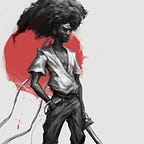Two Interesting Ways Quentin Tarantino Uses Violence in His Movies
Violence as comedy, violence as philosophy
Filmmaker Quentin Tarantino is renown for his fascination with violence.
What I want to do here is talk about two intellectually interesting ways he uses violence that people don’t usually notice.
The less interesting ways are the conventional ones: violence as a dramatic device, violence for shock effect, and violence as an aesthetic.
What we don’t speak about often enough in relation to his movies is how he uses violence for comedic effect and violence as a means to philosophize.
1. Violence as Comedy
He has a talent for making violence look hilarious. Not in the Jackie Chan (Buster Keaton and Charlie Chaplin) way, but in a cathartic sense. When Vincent shoots Marvin in the face (Pulp Fiction) — the instant reaction for me is laughter.
When Brad Pitt kicks Bruce Lee’s ass in Once Upon a Time in Hollywood, that’s hilarious. That scene was ballsy on Tarantino’s part: it raised an uproar and Tarantino was accused of racism for portraying Bruce Lee as a loudmouth caricature who is easily beaten up by a stuntman.
The hippy massacre scene towards the end of that movie also causes a burst of laughter. The movie shows great restraint in that Tarantino does not truly indulge his passion for violence until the very last act of the movie. Tarantino subverting our expectations: after the bloodbath that was Hateful Eight (and most of his movies), we expected a Charles Manson story filled with sadistic violence. Instead, he gifts us a quiet movie where nothing out of the ordinary really happens, a slice of life kind of movie, something we did not expect from the genre-worshipping Tarantino. Then in the last act: an explosion of violence. Giving you a catharsis that will make you react with a burst of laughter.
2. Violence as Philosophy
He has elevated violence into an aesthetic, and even beyond that: given it spiritually or intellectually redeeming properties.
The Bride’s Holy War
Kill Bill works because the violence is in the service of a truly deserved revenge. The bride is waging a holy war on the Deadly Viper Assassination Squad.
As the Bride tells us: “When fortune smiles on something as violent and ugly as revenge, it seems proof like no other that not only does God exist, you’re doing his will.”
Violence as a Means to Justice
And as Budd, the lazy cowboy assassin (a surprisingly wise and self aware character) tells Elle Driver (Cyclops): “That woman deserves her revenge. And we deserve to die.”
The Worship of Tools of Violence
The reverence for Hattori Hanzo swords is transcedental, like the reverence Catholics have for relics, rosaries, and other spiritual objects.
The Wise Proverbs of the Violent
Hattori Hanzo tells the Bride, “Kill whoever stands in thy way, even if that be Lord God, or Buddha himself. This truth lies at the heart of the art of combat.”
Violence as a Means to Give Back Agency to the Downtrodden
The theme of redemptive comeuppance runs through a lot of his movies. Django Unchained subverts the movie Roots”. In Roots, the black man forgives the white man who beat him. In Django, the black man refuses to turn the other cheek.
Inglorious Basterds: what if Jews had killed Hitler and high-level Nazis? Here Tarantino is using violence as a tool give back agency to the oppressed. He is also rewriting history in the process.
Subverting Historical Violence
Once Upon a Time in Hollywood: what if Sharon Tate had lived and the hippies who murdered her had been killed instead? Reimagining the violence in a historic event. Here Tarantino uses the power of cinema to rewrite history and enact a wish fulfillment revenge on the hippies who killed a movie star in her prime. The movie is a love letter to Hollywood, we were told — and in giving a dead movie star, Sharon Tate, back to us alive, that’s exactly what Quentin Tarantino achieves.
